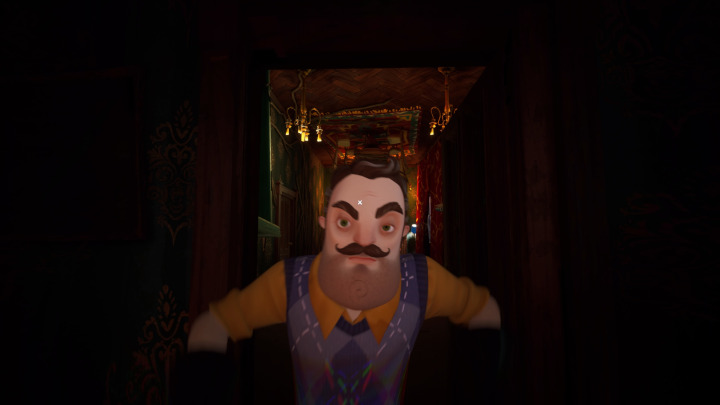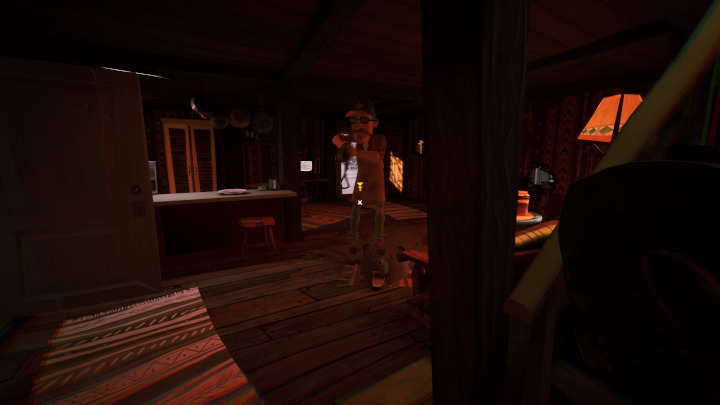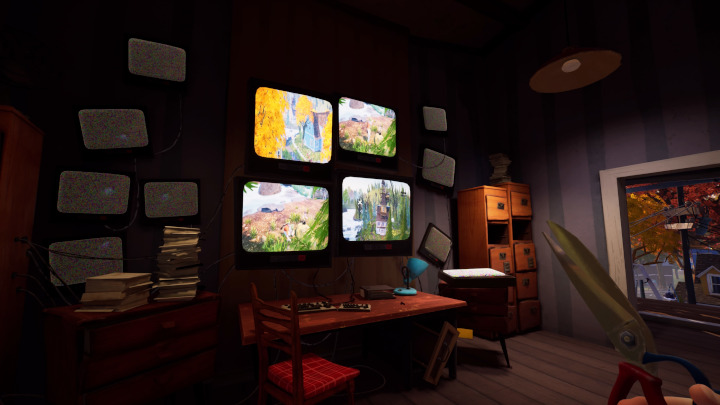
Hello Neighbor 2 is a family-friendly first-person comedy-horror adventure, but more than anything else, it’s a puzzle game. The primary gameplay loop has you wandering around the town of Raven Brooks — or Wayron Croobs — trying to solve various puzzles in an attempt to get to the bottom of a greater mystery. What’s up with that neighbor guy, anyway? What’s going on with those kids? Is there something super sinister brewing, or is this all just some big misunderstanding?
Like all good puzzle games, there’s a logic at play that feels like decoding a language. You’ll feel disoriented in the beginning, seeing various tools strewn about with seemingly no purpose other than to drive you mad. But then you’ll realize that one item is red, and there’s a red piece of a banner above a safe that you’re trying to get into. And then you start noticing the colors of everything, and realizing that various objects in the game are color-coded, and that when you understand what each color means, the solution to one of the game’s earliest puzzles suddenly becomes clear.
It’s like how when you visit a foreign country without bothering to learn the language; very little of what anybody’s saying makes any sense. But once you start to pick up words, and then work out how to piece those words together to make sentences, you can start ordering food off a menu, or getting directions from locals. A world that once seemed vague and disorienting slowly comes into focus.

Hello Neighbor 2 does a very good job of building out a rich and complex puzzle language that makes more and more sense to you the longer you play. Solving puzzles is less about figuring out what the game expects you to be doing and more about learning to decode its language so it can simply tell you.
But Hello Neighbor 2 also tries to be a stealth game, and no matter how good the puzzle side of the equation is, the stealth side is always there to muck things up.
I’ve spoken a lot about stealth games in the past — some of my favorite video games of all time are stealth games, so I have pretty strong opinions about them. And one thing that will make or break every stealth game is the balance of power. Bad stealth games use stealth sequences — areas you have to sneak through without being detected — as a way to disempower the player. Good stealth games, on the other hand, use stealth sequences as a counterweight to keep the amount of power you have at a perfect balance.
For example, in the original Metal Gear Solid, you could tap walls to distract guards. You could make footprints in the snow that enemies would then follow. You could drop flash grenades to blind them. And then, of course, you could sneak up behind them and put them to sleep. With so many tools at your disposal, the prospect of not getting seen gives every piece of your robust toolkit a purpose. What’s the point of distracting a guard if there’s no consequence for being seen?
Hitman 3 is a more recent example, where you must perform assassinations in crowded rooms without drawing suspicion. These tasks seem impossible at first blush, but they become manageable once you acquire a few tools. Use a screwdriver to tamper with some wiring, then to puncture a water cooler to create a deadly shock puddle. Dress like a waiter and poison the target’s coffee. Climb up a pole to sneak into a window, where you can nab a security officer’s disguise and walk around with a loaded weapon without drawing attention to yourself. Hitman 3 is almost like a puzzle game where the stealth parts are the puzzle, yet every scenario has several dozen potential solutions. So you’re not looking for the solution so much as discovering a solution — one of many.

In Hello Neighbor 2, stealth is just there to prevent you from solving puzzles. It doesn’t serve any greater purpose in the overall gameplay loop — it’s just there as a constant thorn in your side. You’re given very few tools to deal with it, though you can admittedly create distractions by turning on television sets or setting alarm clocks. You can also pilot a drone or set up cameras to monitor guards to make sure the coast is clear before you walk into a room. However, using some of these tools is oftentimes more work than just taking a deep breath, crossing your fingers, and stepping into the next room while hoping no one is there to spot you.
The tedium of all this is compounded by the fact that guards in Hello Neighbor 2 don’t really have set routines, and they feel like they’re always in a specific place just to mess with you. For example, if you’re in a two-story building, once you’ve solved the puzzles on the first floor, the guard will move up to the second one. Sometimes this is triggered by something specific that you’ve done, like stepping on a creaky floorboard or a piece of broken glass, but other times it feels completely random. The guy who was just in the living room when you needed to find a clue there is now in the bedroom, because that’s where your next clue is.
To make things even worse, the game is pretty buggy. Sometimes guards will get stuck in a location where they’re looking at the puzzle you’re trying to solve, and the only way to get them to move is by closing the game and re-loading your save file.

This is a constant distraction from the fun part of the game — the puzzle-solving part — that doesn’t really add anything meaningful. You could argue that stealth sequences are there to increase the tension, to create hard failstates that add an element of risk. But really, once you’ve acclimated to them, they’re pretty much just there to prevent you from doing the things you want to do.
To be clear, getting past guards is not a puzzle element in this game, and that’s the part that really breaks them for me. For example, there’s one puzzle where a cat is guarding an item you need. If you can figure out how to get the treat out of the fridge, the cat will be distracted so you can grab the item. And you know what? That works! But the human guards don’t have those kinds of rulesets; they just wander and meander and get themselves stuck in the most inconvenient places.
Hello Neighbor 2 is a very fun game that constantly flirts with true brilliance, but its stealth sections are always there to slam on the breaks and say, “Hey buddy, you might be enjoying this just a little bit too much. I think it’s time to turn down the fun factor by a few notches.” As much as I want to enjoy this game — I was having an absolute blast in the first section — the stealth mechanic is just too aggressively bad.
The way I see it, it’s like there’s a delicious cake waiting for you on the table, but you stub your toe on a chair on the way toward the cake. Does stubbing your toe make the ultimate reward of eating the cake feel more satisfying, or does it just sour your mood enough that the cake doesn’t taste quite as good as it could if your toe weren’t throbbing in pain? When it comes to Hello Neighbor 2, the puzzles are the cake and the stealth sections are the chair you’ll stub your toe on.

Hello Neighbor 2 is basically a really good puzzle game that’s stuffed inside a really bad stealth game. If it just dropped the stealth part, there’s a genuinely great experience to be had. But this game pretends to be a stealth game so, so hard, and those bad parts are constantly getting in the way of the good stuff.
Disclaimer: I was given a review code for Hello Neighbor 2 on PS5, but the opinions expressed in this article are my own.